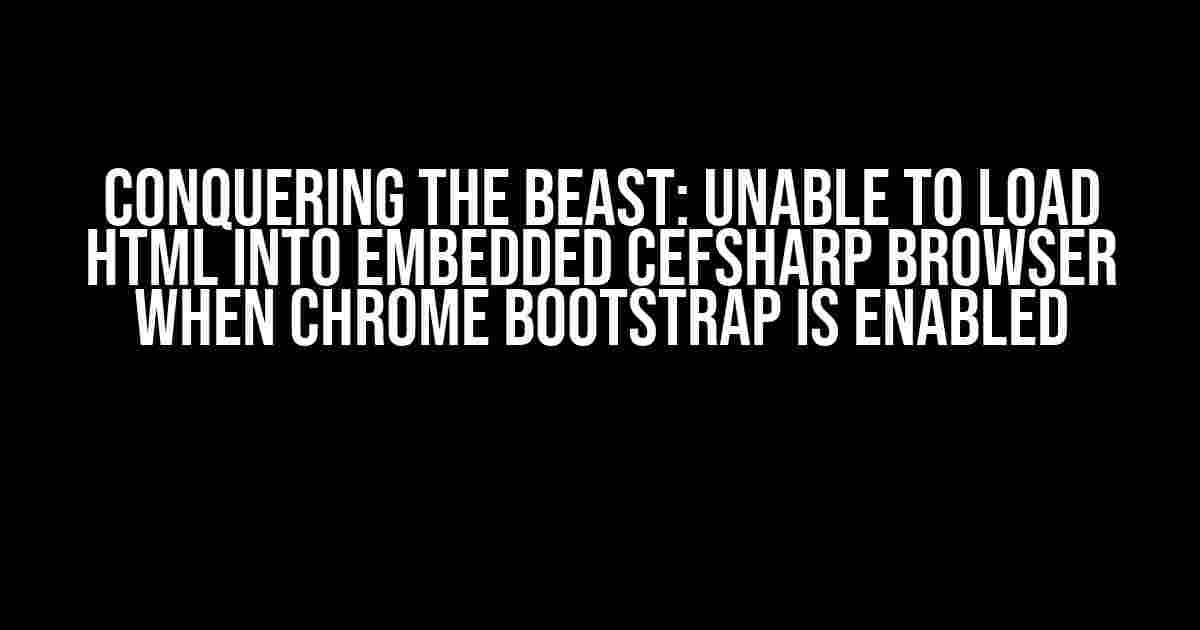Are you tired of scratching your head, wondering why your HTML content refuses to load into your embedded CefSharp browser? Do you find yourself stuck in a vortex of frustration, with Chrome bootstrap enabled and your HTML files nowhere to be found? Fear not, dear developer, for we’re about to embark on a journey to vanquish this beast and get your HTML loading smoothly into your CefSharp browser.
Understanding the Problem
Before we dive into the solution, let’s take a step back and understand the root of the issue. When you enable Chrome bootstrap in your CefSharp browser, it can sometimes cause issues with loading HTML content. This is because the bootstrap process can interfere with the browser’s ability to load local HTML files.
Why Does This Happen?
There are a few reasons why this might occur:
- Chrome bootstrap can priorities its own resources over local HTML files.
- The bootstrap process might be conflicting with the browser’s internal resource loading mechanism.
- Corrupted or incomplete bootstrap files can cause issues with HTML loading.
The Solution
Now that we’ve identified the problem, let’s get down to business and explore the solution. Don’t worry, it’s easier than you think!
Step 1: Disable Bootstrap
The first step is to disable Chrome bootstrap in your CefSharp browser. You can do this by setting the CefSettings.EnableBootstrap property to false when creating your browser instance:
var settings = new CefSettings();
settings.EnableBootstrap = false;
browser = new ChromiumWebBrowser("https://example.com", settings);By disabling bootstrap, you’re allowing the browser to load local HTML files without interference.
Step 2: Load HTML Using the LoadHtml Method
Next, you’ll need to load your HTML content using the LoadHtml method. This method allows you to specify the HTML content as a string, which will be loaded into the browser:
string html = "<html><body><p>Hello, World!</p></body></html>";
browser.LoadHtml(html, "https://example.com");Make sure to specify the base URL as the second argument, which will help the browser to load any relative resources correctly.
Step 3: Use the LoadUrl Method with a Local File
Alternatively, you can load your HTML file using the LoadUrl method, specifying the file path as the URL:
string filePath = @"C:\path\to\your.html";
browser.LoadUrl($"file://{filePath}");Ensure that the file path is correct and the file is accessible by the browser.
Troubleshooting Tips
If you’re still experiencing issues with loading HTML content, here are some troubleshooting tips to help you:
| Issue | Solution |
|---|---|
| HTML file not found | Check the file path and ensure it’s correct and accessible. |
| Bootstrap conflicts | Disable bootstrap or try loading HTML using the LoadHtml method. |
| Corrupted bootstrap files | Try reinstalling CefSharp or clearing the browser’s cache. |
Conclusion
And there you have it! With these simple steps, you should be able to load your HTML content into your embedded CefSharp browser even when Chrome bootstrap is enabled. Remember to disable bootstrap, use the LoadHtml method, and troubleshoot any issues that arise. Happy coding!
For further reading and resources, be sure to check out the official CefSharp documentation and the CefSharp community forums.
Now, go forth and conquer that HTML loading beast!
Additional Resources
Want to learn more about CefSharp and HTML loading? Check out these additional resources:
We hope you found this article helpful in resolving the issue of loading HTML content into your embedded CefSharp browser when Chrome bootstrap is enabled. Happy coding, and don’t forget to share your experiences and tips in the comments below!
Frequently Asked Questions
Having trouble loading HTML into your embedded CefSharp browser when Chrome bootstrap is enabled? Don’t worry, you’re not alone! Here are some frequently asked questions and answers to get you back on track.
Why does Chrome bootstrap interfere with HTML loading in CefSharp?
Chrome bootstrap can conflict with the CefSharp browser’s ability to load HTML content because it initializes the Chrome browser process, which can override the CefSharp browser’s settings. This can lead to issues with HTML loading, rendering, and even JavaScript execution.
How can I resolve the HTML loading issue when Chrome bootstrap is enabled?
One way to resolve this issue is to disable Chrome bootstrap before initializing the CefSharp browser. You can do this by adding the `–disable-extensions` command-line argument or by setting the `CefSettings.DisableExtensions` property to `true`. This will prevent Chrome bootstrap from interfering with the CefSharp browser’s HTML loading capabilities.
What are the potential consequences of disabling Chrome bootstrap?
Disabling Chrome bootstrap may affect the performance and functionality of your CefSharp browser. Some features, such as GPU acceleration, may not work as expected. Additionally, disabling bootstrap may also impact the browser’s security features, such as sandboxing. Be sure to weigh the pros and cons before deciding to disable Chrome bootstrap.
Can I load HTML content in CefSharp without disabling Chrome bootstrap?
Yes, you can load HTML content in CefSharp without disabling Chrome bootstrap. One approach is to use the `LoadHtml` method and specify the HTML content as a string. This allows you to load HTML content without relying on the file system or network resources. However, this approach may not work for all use cases, so be sure to test thoroughly.
What are some best practices for using CefSharp with Chrome bootstrap enabled?
When using CefSharp with Chrome bootstrap enabled, it’s essential to follow best practices, such as properly configuring the CefSettings, setting the correct browser sandboxing mode, and ensuring that the browser is properly initialized and disposed. Additionally, be mindful of the browser’s memory usage and performance, and consider implementing mechanisms to handle crashes and errors.

